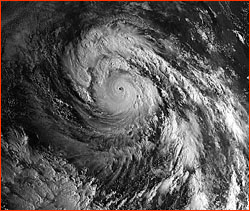 |
 |

|
The Greatest Catastrophe That Never Happened A Guest Dispatch: February 11, 1998 By meteorologist Peter R. Chaston previous | next With all of the recent focus on storms lashing California and Peru, it's amazing to me that most people don't realize that in September, only by some last minute luck, Los Angeles avoided what would have been the costliest and most destructive weather catastrophe of all time. The bullet was in the chamber, and the gun was pointed at Los Angeles.... In the winter of 1982-83, El Niño pummeled California and the West Coast with a series of powerful storms. South of the equator, its rains transformed the coastal deserts of Peru and Ecuador into grasslands dotted with lakes and ponds; other effects led to massive bird and fish migrations away from the South American coast. So, when surface water temperatures jumped almost 10 degrees Fahrenheit above normal off Peru and Ecuador last summer, meteorologists concluded that a major El Niño was underway, and knew what to expect. Armed with new models, and given an earlier warning than ever before, meteorologists issued advisories, detailing the possible serious weather that might again plague the west coasts of both of the American continents. In particular, residents of southern California took the warnings to heart. Scientists feared that an eastern pacific hurricane could take a northward journey and decimate Southern California. Three key initial conditions caused by El Niño were coming together to create an ominous threat to the area from San Diego to Los Angeles:
On September 9th, 1997, Hurricane Linda formed about 700 miles south-southwest of the Baja peninsula. As the storm slowly moved north-northwestward, running along the Mexican coastline, El Niño's warm waters caused Linda to grow explosively into a large howling hurricane, with
As the clock ticked and the storm raged, terrifying forecasts spewed from computer models; the storm would most likely slam the coast somewhere between San Diego and Los Angeles, more probably at Los Angeles. A hurricane requires surface water temperatures of at least 79 degrees Fahrenheit to keep growing. El Niño had made the water temperatures ideal all the way up to the California border, greasing the slide. Los Angeles' fate seemed sealed. At almost the last moment, an upper-level trough (a fancy term for a sharp dip in higher-level winds) moved erratically, and Hurricane Linda was turned out to sea as it neared the California border. The only time in history a hurricane with winds over 100 miles per hour has struck Los Angeles was on August 23rd, 1838, and that leveled the then-small city. In 1997, Los Angeles came incredibly close to experiencing a direct-hit assault by the most powerful Eastern Pacific hurricane in history! I inspected the Homestead area of south Florida, along with National Hurricane Center specialists, after Hurricane Andrew smashed through in 1992, with winds of at least 140 mph, and gusts of 175 mph. Many homes there are similar in construction to southern California homes. Andrew destroyed or damaged virtually every building there, and his winds were weaker than those of Linda, his size was smaller, and his movement was faster. From my perspective, I can assure you Linda would have made the damage done by Andrew seem almost moderate. Most roofs cannot sustain continued winds in excess of 100 miles per hour. After the roof goes, the walls and rest of the house are blown apart like matchwood. I saw it in Andrew, a weaker storm than Linda; Linda would have steam-rollered Los Angeles. Clearly Linda would have the exceeded in Los Angeles the 25 billion dollars of damage that Andrew caused in Florida. That should give you a little perspective when you watch news accounts of the rains and flooding this week. It could have been - should have been - far, far worse. Peter Chaston is a professional meteorologist, weather consultant, and author of "Terror from the Skies" and "Hurricanes!" In 1995, Chaston predicted that the next El Niño would be abnormally strong. previous dispatch | next dispatch | table of contents Photo: NASA Anatomy of El Niño | Chasing El Niño | El Niño's Reach Dispatches | Resources | Mail | Site Map | El Niño Home Editor's Picks | Previous Sites | Join Us/E-mail | TV/Web Schedule About NOVA | Teachers | Site Map | Shop | Jobs | Search | To print PBS Online | NOVA Online | WGBH © | Updated November 2000 |
||||
